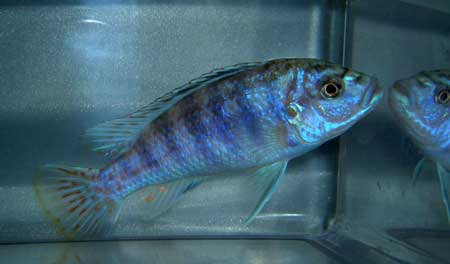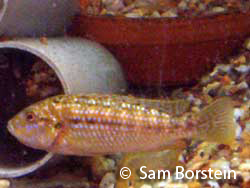Labidochromis joanjohnsonae
Johnson, 1974
Pearl of Likoma, Exasperatus
Synonyms: Melanochromis exasperatus, Melanochromis joanjohnsonae


Above: A male Labidochromis joanjohnsonae. Photo by Sue Ewald.
Etymology:
Genus- labis= tongs (Greek), chromis= a fish, perhaps a perch (Greek).
Species- joanjohnsonae= Named after Joan Johnson.
Intro:
Labidochromis joanjohnsonae is a relatively popular fish in the hobby. This fish, first typed by Johnson in 1974 is dedicated to his wife. Like most mbuna, males are colorful, but as a bonus, so are females in this species. The females in some ways are even more attractive than the males with a nice silvery-blue color with red dots. Some scientists debate what genus this species should be placed in (Konings, 2007). While some think it should be Labidochromis, others believe it should be Melanochromis. Personally, I think it's fairly obvious this fish belongs in Labidochromis.
Distribution:
This fish is endemic to Likoma Island and is associated with rocky areas.
Size, Maturity, and Sexual Dimorphism:
Size: Males- 5 inches, Females- 4 inches
Maturity: 2 inches
Sexual Dimorphism: Males are larger and blue; females are a silvery blue with orange dots throughout. Young have the same coloration of the females.
Care:
Labidochromis joanjohnsonae is easy to care for as long as you can manage aggression. Males are intolerant of other males and can harass females to quite an extent. Make sure the tank is large if you want to keep a group of 5 or more. A tank of 75 gallons is adequate for this task. Also, make sure there are lots of rocks in the tank. This fish mixes well with other aggressive mbuna and larger Malawi Haps.
Diet:
This fish is an insectivore in the wild. Feed a balanced diet with some protein rich and veggie foods.
Breeding:
This fish was not very hard to spawn. The problem is keeping females alive to spawn because of aggression stated above. The fish breed like most mbuna, so nothing unusual.
Females are good holders and can be hard to strip. If small enough, you can try stripping a fish by putting them in a turkey baster. The females hold about 2 weeks and the fry are small. Rear the fry with baby brine shrimp and later flake food.
The fry are relatively fast growing and colorful, which is nice.

Above: A holding female Labidochromis joanjohnsonae. Photo by Sam Borstein.
Conclusion:
Labidochromis joanjohnsonae is a nice fish to keep. Dealing with the aggression can be a bit of a nuisance though. What is nice about this fish is that it is colorful and even females will add color to a tank. You may even be able to find this fish at a cheap price at your local pet shop.
References:
- IUCN. IUCN Red List of Threatened Species. <http://www.iucnredlist.org>.
- Johnson, D. S. (1974). New cichlids from Lake Malawi, including descriptions of two new species. Today's Aquarist, 1, 12-17.
- Konings, A. (2007) Malawi cichlids in their natural habitat. 4th ed., Cichlid Press, El Paso, Texas, 424 pp.
